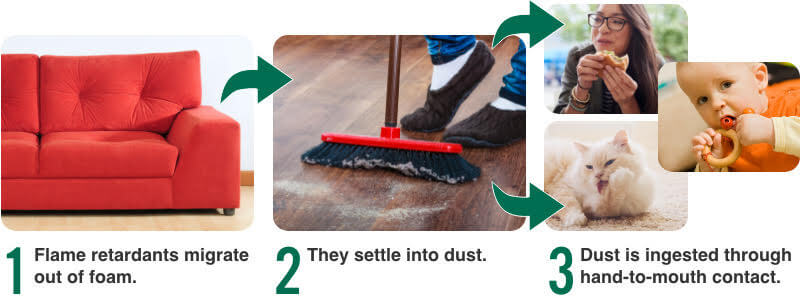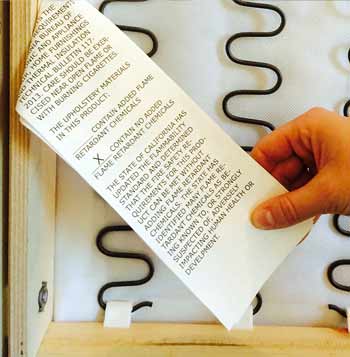Flame Retardants in Furniture
Furniture flame retardants harm our health and do not prevent fires
Our Institute led changes to flammability standards that prevented the unnecessary use of tens of millions of pounds of flame retardants in furniture. This protects people and ecosystems from serious harm.

Why are flame retardants in furniture?
A 1975 California furniture flammability standard called Technical Bulletin 117 (TB 117) led to the use of harmful and ineffective flame retardant chemicals in furniture and children’s product foam. This California regulation was followed across all of North America.
TB 117 required the foam inside furniture to withstand a small open flame for 12 seconds. However, in a real fire the cover fabric will ignite first, leading to a large flame which will quickly ignite the foam, even if it contains flame retardants. In fact, furniture with and without flame retardants burns similarly. Read the peer-reviewed study, published in Fire Safety Science.
And the flame retardants weren’t just ineffective—their use was widespread. In collaboration with Dr. Heather Stapleton at Duke University, we tested the foam of 101 American couches bought between 1984-2010. We found that 85% of the couches contained harmful or inadequately tested flame retardant chemicals in the foam.
Why does it matter?
Flame retardants continually migrate out of furniture and into indoor dust which is ingested by people and pets. Some of these chemicals are associated with lowered IQ in children, cancer, hormone disruption, and other health problems. Learn more about common flame retardants and their health harm on our flame retardants page.
How are we exposed?

How have we reduced flame retardants in furniture?
In 2010 we helped to draft the San Antonio Statement on Brominated and Chlorinated Flame Retardants. This consensus statement, signed by over 200 experts from 30 countries, details research documenting the health harm and lack of fire safety benefit from flame retardants.
After further science and advocacy by the Institute and our colleagues, California’s governor directed the state to revise TB 117 to a new standard, TB 117-2013, which became mandatory for new furniture manufactured after January 1, 2015. The new standard provides for better fire safety in furniture and children’s products without the need for flame retardant chemicals.
In 2015 the Institute and our colleagues petitioned the U.S. Consumer Product Safety Commission (CPSC) to ban products, including furniture, containing any organohalogen flame retardant. The petition asked the CPSC to adopt rules under the Federal Hazardous Substances Act to protect consumers from all organohalogen flame retardants in furniture, children’s products, electronics casings, and mattresses.
In a landmark 2017 decision, the CPSC granted our petition. However, the ban of this toxic class of flame retardants will take years to implement. There is also concern that manufacturers will move from organohalogens to organophosphates and other types of toxic flame retardants. You can learn more about the petition here.
How can I tell if there are flame retardants in my furniture?
A California law called SB 1019 requires upholstered furniture to have a label stating whether or not the item contains flame retardants. More information on how to easily identify safer furniture can be found in this fact sheet.

If you have upholstered furniture manufactured before 2015 it is likely to contain flame retardants. However, you might be able to replace the foam with healthier flame retardant-free material and keep the furniture. Find out more about furniture foam replacement here.
Starting in 2020 a California law bans the sale of new upholstered furniture, juvenile products, and mattresses containing most flame retardant chemicals.
Resources
Science:
- Organophosphate ester flame retardants: are they a regrettable substituion for polybrominated diphenyl ethers?
- Novel and high volume use flame retardants in US couches reflective of the 2005 pentaBDE phase out
- Flame retardants in furniture foam – Benefits and risks
- Flame retardants in furniture – Health, environment and fire safety
Consumers:
- How to buy furniture without flame retardants
- How to replace furniture foam
- Parents’ guide to flame retardants
- Learn more on our Consumer Resources page